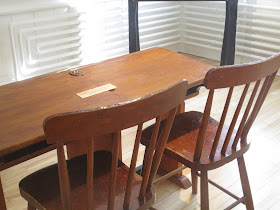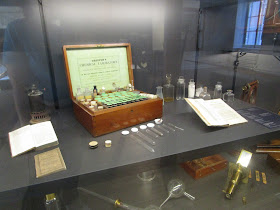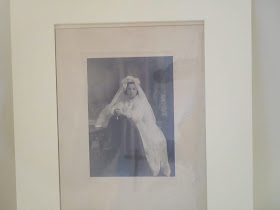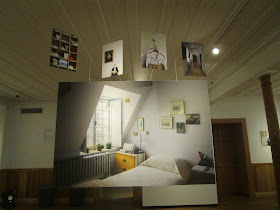The wealth of the church in France allowed them to extend their mission of converting the world to the Catholic faith to America. There was a rivalry during the Protestant Reformation for converts resulting in the Counter Reformation. The Jesuits were the first of the religious orders to arrive in New France with the purpose of converting the Native population.
The clergy were literate, unlike many of the ordinary citizens of Quebec. The clergy kept the records we now use to trace our families, which was a great service. In places like the early American South few, if any, records were kept, and it's nearly impossible to trace anyone beyond the late 18th Century.
I found visiting what we would call in the states convents in Quebec City to be fascinating. A Great-Great Aunt was a Nun, and she worked in the Catholic girls boarding schools in Chicago, Illinois. The Ursuline Monastery/Convent Museum was quite interesting for me for that reason. My father talked about his Great-Aunt Sr. Mary Kathleen frequently. He would visit with her when his family lived in Chicago. He sent Rose Parade programs to her when the family moved to California. She would share them with the girls at the school, which made her very popular.
A Virtual Tour of the Ursuline Museum in Quebec City
Arrival in New France
The Ursulines were founded in New France when Marie L'Incarnation arrived from France in 1639, with Marie-Madeleine de Chauvigny de la Peltrie. Peltrie financially supported the group. Marie L'Incarnation, because she was a woman, was discouraged from coming to the New World, and had to plead for financial assistance to fund her voyage to America. As a leader of the Ursulines in the New World she established the first girls school in Quebec. The school was designed to educate both French girls and the indigenous population in the Christian faith. Filles du Roi were also sometimes housed with the Ursulines when they arrived.Both Marie de L'Incarnation and Marie-Madeleine de Chauvigny de la Peltrie were widows. Marie de L'Incarnation left a son in the care of family in order to devote her life to the church. Her son also joined a monastic order when he grew up, and the letters they exchanged form an important source of information about life in New France.
A door from the house of Marie-Madeleine de Chauvigny de la Peltrie can be seen in the Ursuline Museum.
These Nuns, who were cloistered in their convent, were known for producing lace work, and other fine needle work such as vestments for the church. Using shiny gold and silver thread, and other vibrant colors, they produced masterpieces in the form of textiles. The Native American and French students of the Ursuline school were taught the art of fine needle work by the sisters. Marie de L'Incarnation's father was a silk merchant which probably added to her knowledge of the art of working with textiles.
Becoming an Ursuline Nun
The Ursulines provided important services for Quebec with their teaching and needle work. The order soon expanded to places like Trois-Rivieres and beyond. The expansion created a need for more women to join the order. It was always difficult to lure people to come to Quebec where the winters are harsh, and there was a threat of Indian attack. They had to recruit from the local population. The French Canadians were encouraged to marry very young and have large families to increase the population so that France could hold on to the land. These large Catholic families often were encouraged to send one of their children to join a religious order.
The process of joining the Ursulines as a Nun is covered in a special exhibit room in the museum. Your first step, of course, would be to pack up your worldly items in a trunk to be brought to the monastery where it would be stored in the attic.
Before officially joining the order a woman must serve a trial period as a novice.
Once the candidate/postulate for admission to the order is accepted a ceremony of taking the veil is performed. At this ceremony the postulate is officially recognized to "be dead to the world, to your parents, to your friends and to yourself." As the display at the Ursuline museum states, "The Vestition Ceremony marked the postulates death to the world, as she gave up her secular dress to adopt the religious habit. This symbolic death was followed by an equally symbolic rebirth." The novices used to wear wedding dresses to symbolize their marriage to the church.
During the ceremony the postulate would change into a black habit symbolizing her death to the world.
Once she is dead to the world she is stripped of her family name, another symbol of her secular death, and given a new name chosen by the Mother Superior. My great-great Aunt was given the name Mary Kathleen.
A belt was wrapped around the postulates to symbolize that they were now under the authority of the hierarchy of the church.
At this point the postulate is a novice. After serving her novitiate she can decide to take her final vows.
After you were admitted you lived behind a barred grill in the Monastery/Convent. The Nuns had their own chapel for services barred off from the rest of the worshipers.
The Ursuline School
The original mission of the Ursuline girls school was to convert the indigenous people to Catholicism. It was hoped that these girls would return to their villages and convert more of their people, and raise their children as Catholics. Cultural differences created a barrier when it came to trying to integrate the indigenous population into French culture. The girls were often homesick and would jump the fence and rejoin their families.
The Nuns were involved in continuing their own education also. They were required in their Constitutions to learn Native American languages to better communicate with the girls. Once the British took over governance of the colony they also learned English.
The school evolved over time and became a boarding school for the French Canadian, and later the Irish, and English population.
Like the Nuns the first step in entering boarding school would be packing your trunk with your belongings. Some of the girls being very young would pack a doll to bring with them.
The girls would be dropped off at school and they would be cloistered behind grill bars like the Nuns. Parents could only visit students infrequently, with permission.
Oral histories of former boarding schools students can be heard using headphones in the museum. One former student said she would cry herself to sleep when she was homesick.
The Nuns were kept busy caring for all the needs of the girls. Nuns cooked the meals, educated, and nursed the girls when they were sick. They, of course, provided them with a Catholic religious education.
Each girl had a place at the meal tables. They kept their plates, cups, and eating utensils in drawers that were built into the tables.
The girls also viewed some members of the staff as family substitutes, which they called aunts or Matantes in French.
There were many changes in the curriculum as times changed. In the 18th Century the arts were stressed as a way of refining the girls for a good marriage. They learned needlework, drawing and painting. They would also learn to play instruments and sing.
Below is a description of a course of study for the girls at this school. The girls received a well rounded education which included education in the arts and sciences. There is also a list of the supplies girls' parents needed to equip their daughters with. Oddly the school didn't furnish eating utensils or table napkins? I guess you could bring your own bedroom furniture, or pay to rent the school furniture
The museum has exhibits demonstrating the wide range of study of the schools students.
Don't know much about history? It sounds like this school was a good place to learn history.
In the 19th Century jewelry made from hair was popular in many western countries. The Nuns responded to this fad with a curriculum that included the making of this jewelry. They also used wax to make interesting novelty items.
There were debates on what should be included in the girls curriculum. In the Early 20th Century the course of study became more narrow with Home Economics becoming central. It was felt that girls mainly needed to be prepared for their roles as wives and mothers. Housekeeping skills such as cooking, ironing, and sewing clothing for the family were taught.
Forms of Punishment changed over time. Originally punishments could be corporal. That was one reason the Native people resisted sending their children to these schools. Native Americans were against any kind of punishment for children.
Rewards.
The Nuns were fully equipped to handle most illnesses the girls came down with. Any kind of contagious illness spread like wildfire.
Keeping the girls healthy meant keeping the buildings clean, and the girls in strong physical shape. Exercise was recognized as a way to stay healthy. Gym equipment was provided and psychical education was part of the curriculum.
The girls also were provided with games and toys for entertainment. One reason I would have rather lived with my Catholic French Canadian ancestors rather than my strict Protestant ancestors who believed having fun was somehow evil. The French Canadians were generally in favor of having fun.
Forms of Punishment changed over time. Originally punishments could be corporal. That was one reason the Native people resisted sending their children to these schools. Native Americans were against any kind of punishment for children.
Rewards.
The Nuns were fully equipped to handle most illnesses the girls came down with. Any kind of contagious illness spread like wildfire.
Girls could fake illness to get out to classes.
Keeping the girls healthy meant keeping the buildings clean, and the girls in strong physical shape. Exercise was recognized as a way to stay healthy. Gym equipment was provided and psychical education was part of the curriculum.
The girls also were provided with games and toys for entertainment. One reason I would have rather lived with my Catholic French Canadian ancestors rather than my strict Protestant ancestors who believed having fun was somehow evil. The French Canadians were generally in favor of having fun.
Religious organizations also helped the girls fill their time, and form bonds that lasted even after they left school.
Preparing girls to become full members of the Catholic Church would have meant preparing them to receive the sacraments. The sacrament of First Holy Communion is an important right of passage and a time of celebration. A record would be kept listing the date of the event and the names of the girls.
Religious feast days, and other special religious holidays, would have been days of celebration and a break from studies.
Despite the homesickness the girls did form bonds with their classmates and the Nuns. Leaving this controlled environment must have been a little jarring for the girls, just as it was entering in the first place.
The museum preserves records and photos of the girls who attended the school over the decades. You can hear recollections of former students using the headphones provided at the museum.
Photos of the last remaining Nuns are on display in a special exhibit. Only two are still living in the convent, the others are living in an assisted living facility.
The Ursuline Nuns who dedicated their lives to educating girls provided an important service to society. They educated not only Catholic girls, but also non Catholics. Boarding schools like this one provided a topnotch education. Thomas Jefferson sent his daughters to a Catholic boarding school in Paris when he was living there. Visiting the Ursuline museum will give you an appreciation for the Nuns and their dedication to education. (Next up will be the Augustines and their mission to care for the sick).





















































































Thank you for this very interesting and informative article!
ReplyDelete